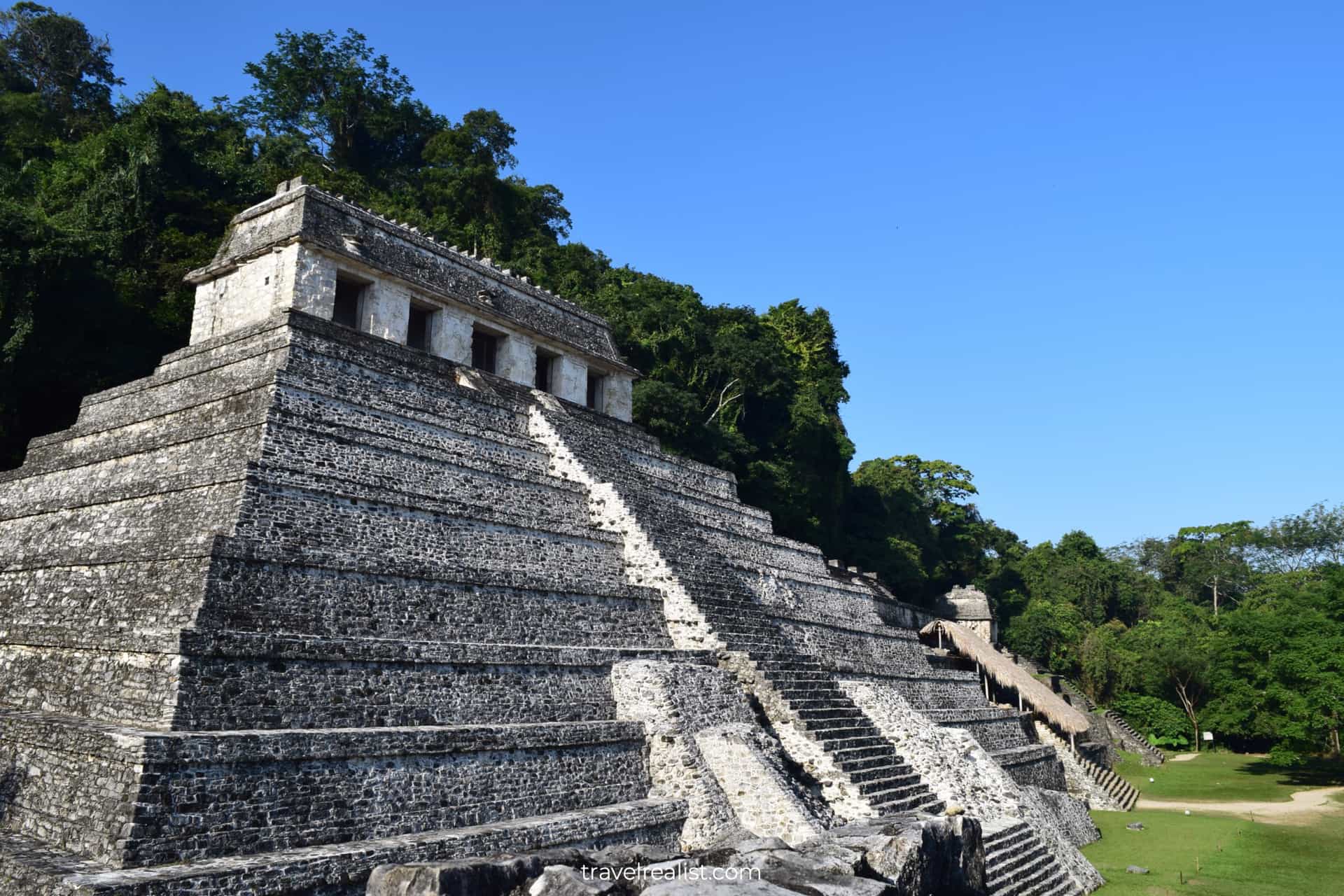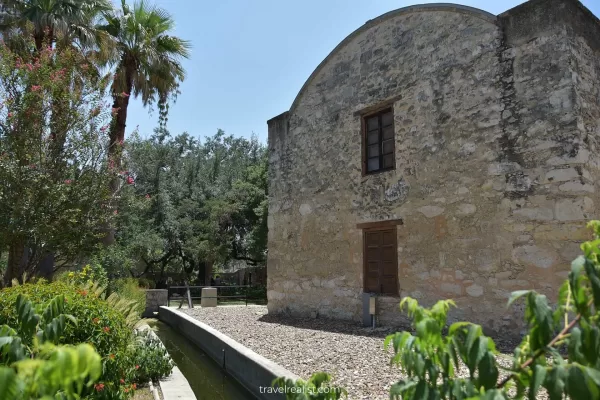Badlands: 15 Not So Bad Stops on The Loop Drive
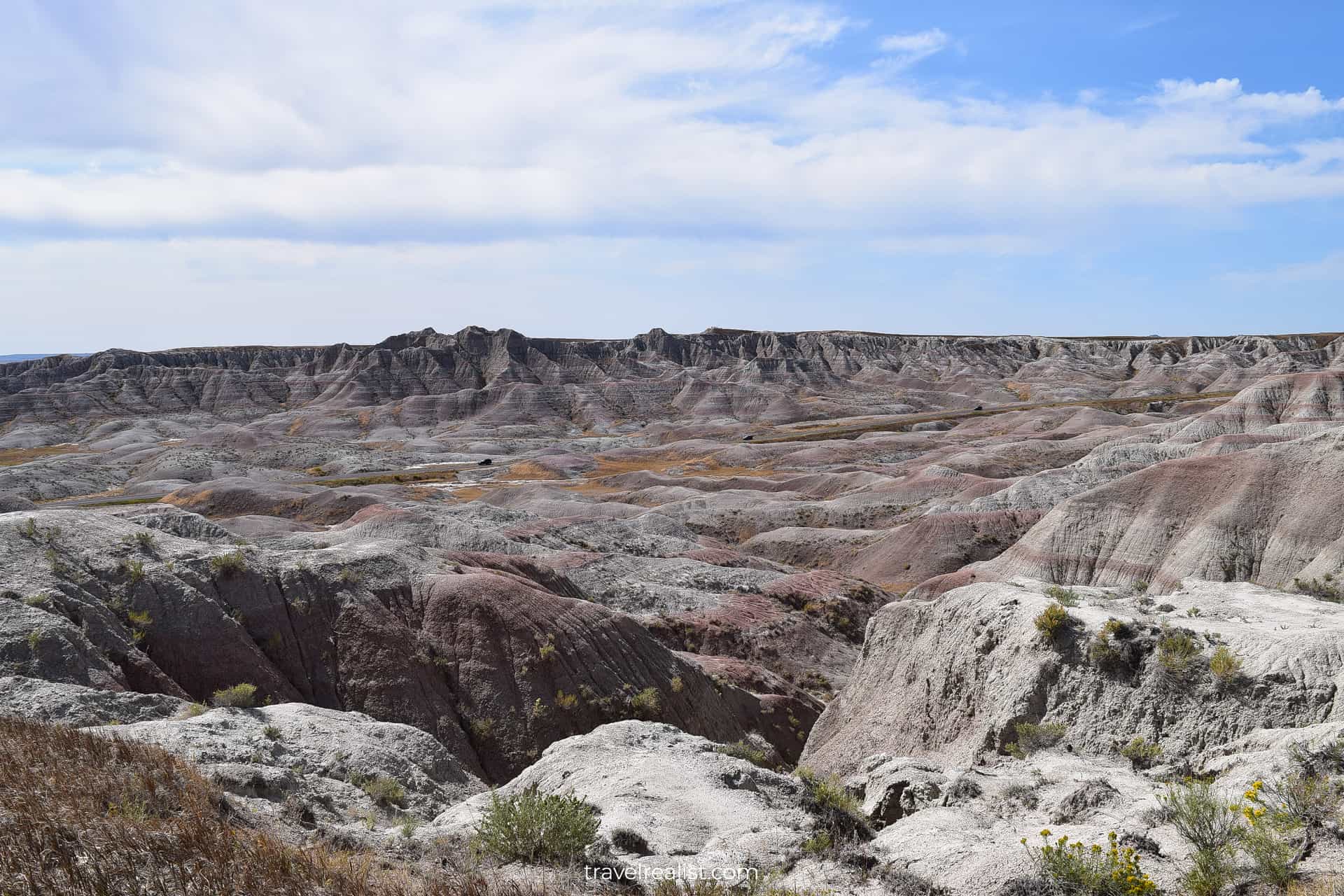
This realistic Badlands National Park Guide helps you plan your next scenic loop drive in the park.
Badlands National Park is a park that protects the formations rich landscapes. These fields are not suitable for agriculture.
This is where the name Badlands comes from. But they are great for a scenic drive and wildlife watching.
- Sights & Places of Interest
- 1. Badlands Loop Road
- 2. Big Badlands Overlook
- 3. Castle Trailhead
- 4. Cliff Shelf Nature Trail
- 5. White River Valley Overlook
- 6. Big Foot Pass
- 7. Panorama Point
- 8. Prairie Wind Overlook
- 9. Burns Basin Overlook
- 10. Homestead Overlook
- 11. Conata Basin Overlook
- 12. Yellow Mounds Overlook
- 13. Ancient Hunters Overlook
- 14. Pinnacles Overlook
- 15. Sage Creek Rim Road
- Getting to Badlands National Park
- Where to Stay near Badlands
- Entrance Requirements & Passes
- Takeaways: Badlands National Park Scenic Loop Drive
This post includes affiliate links that will earn us commission if you make a purchase via these links.
Sights & Places of Interest
Badlands National Park has three units: North, Stronghold, and Palmer Creek.
- Only the North Unit has paved roads.
- The other two units protect the Badlands Wilderness Area. There are few viewpoints. They are also harder to reach.
This Badlands National Park Guide will focus on the sights along the scenic loop drive in the North Unit.
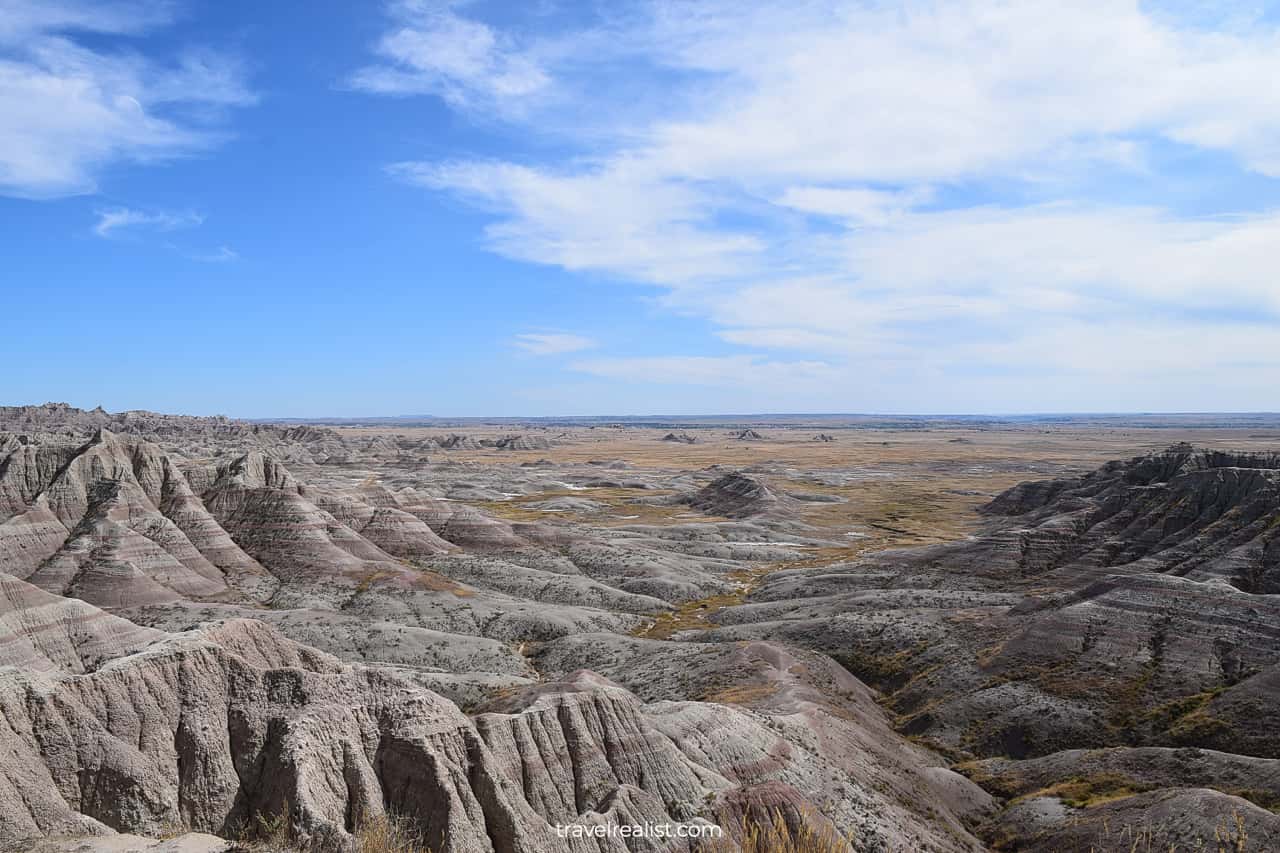
1. Badlands Loop Road
The Badlands Loop Road (SD-240) is the main road through the North Unit of the park. It is also the main paved scenic route in Badlands. It connects a handful of viewpoints in the park over 27 miles (43 km).
There are three entrances to the Badlands Loop Road.
- The Pinnacles Entrance and Northeast Entrance connect the park with Interstate I-90 and Minuteman Missile National Historic Site.
- The Interior Entrance is closest to State Highway SD-44.
No matter what entrance to the North Unit you take you will proceed through Buffalo Gap National Grassland. This is a beautiful area of endless grass fields.
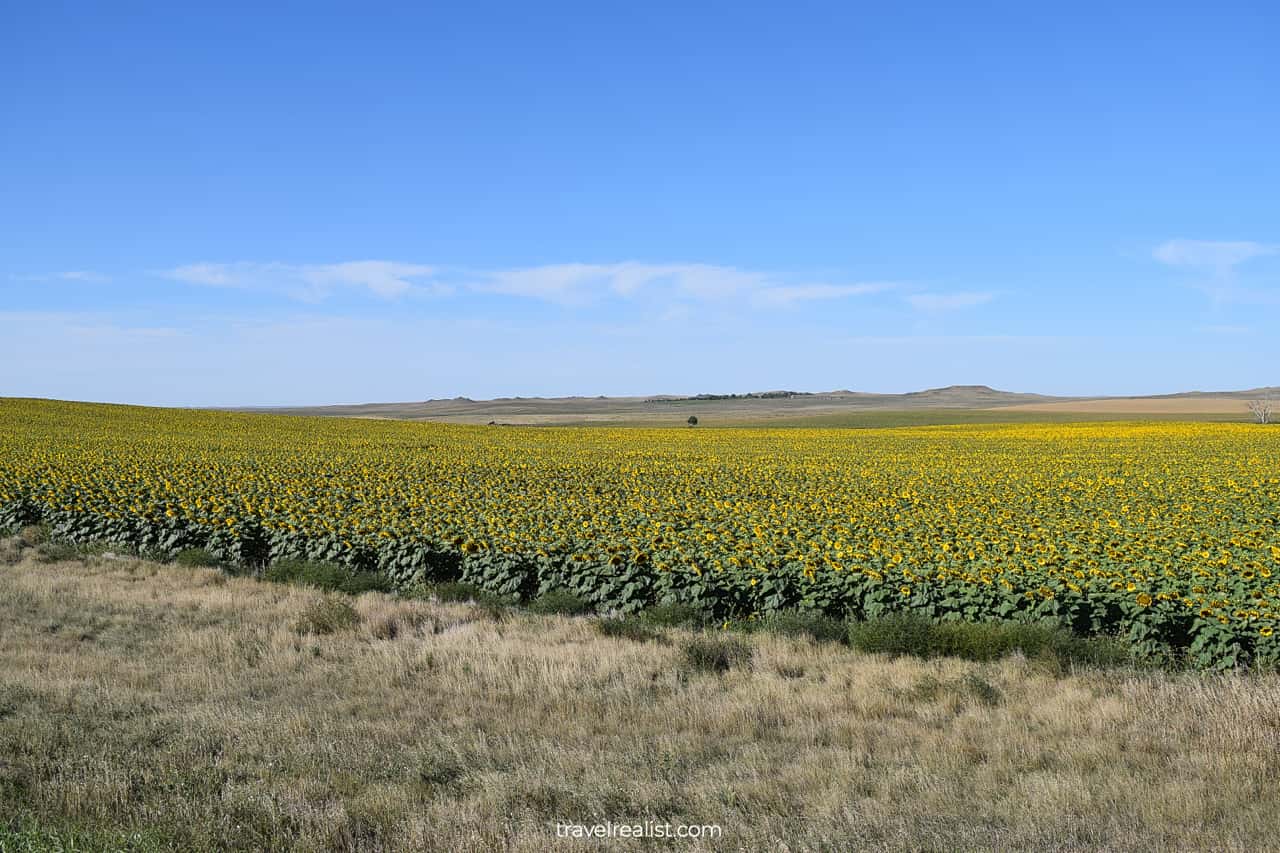
2. Big Badlands Overlook
The Big Badlands Overlook will be your first viewpoint in the park if you enter via the Northeast Entrance Station.
This viewpoint lives up to its name. It offers panoramic views of the badlands. The badlands landscape clearly stands out after a long drive through Buffalo Gap National Grassland.
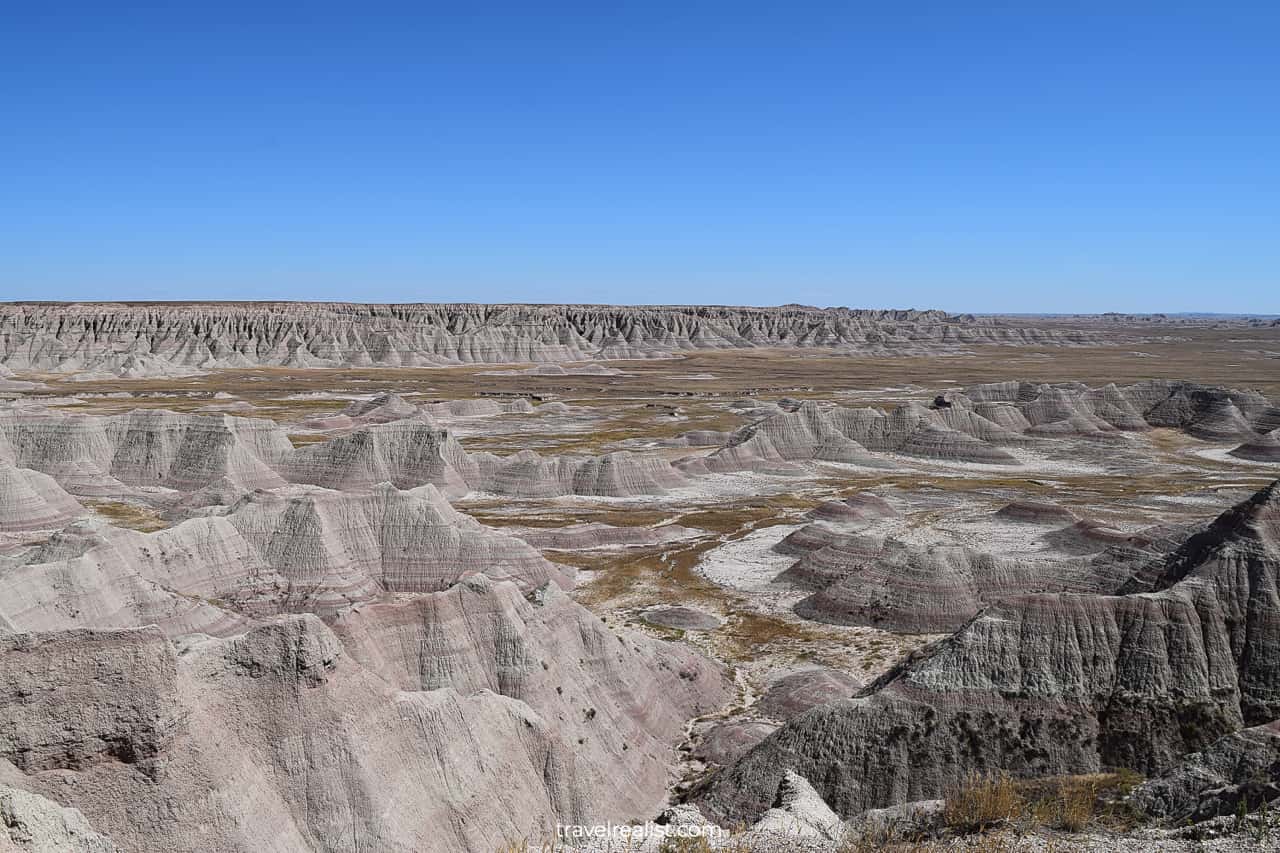
3. Castle Trailhead
The Castle Trailhead is the next stop on the Badlands Roop Road. It is just two miles south of the Big Badlands Overlook.
This trailhead is the starting point to one of the few trails in the park. There are just two trails over 1.5 miles (2.4 km) in Badlands National Park.
These are the Castle and the Medicine Root trails. They are in the same area of the park. You can switch to the Medicine Root Trail about halfway into the Castle Trail.
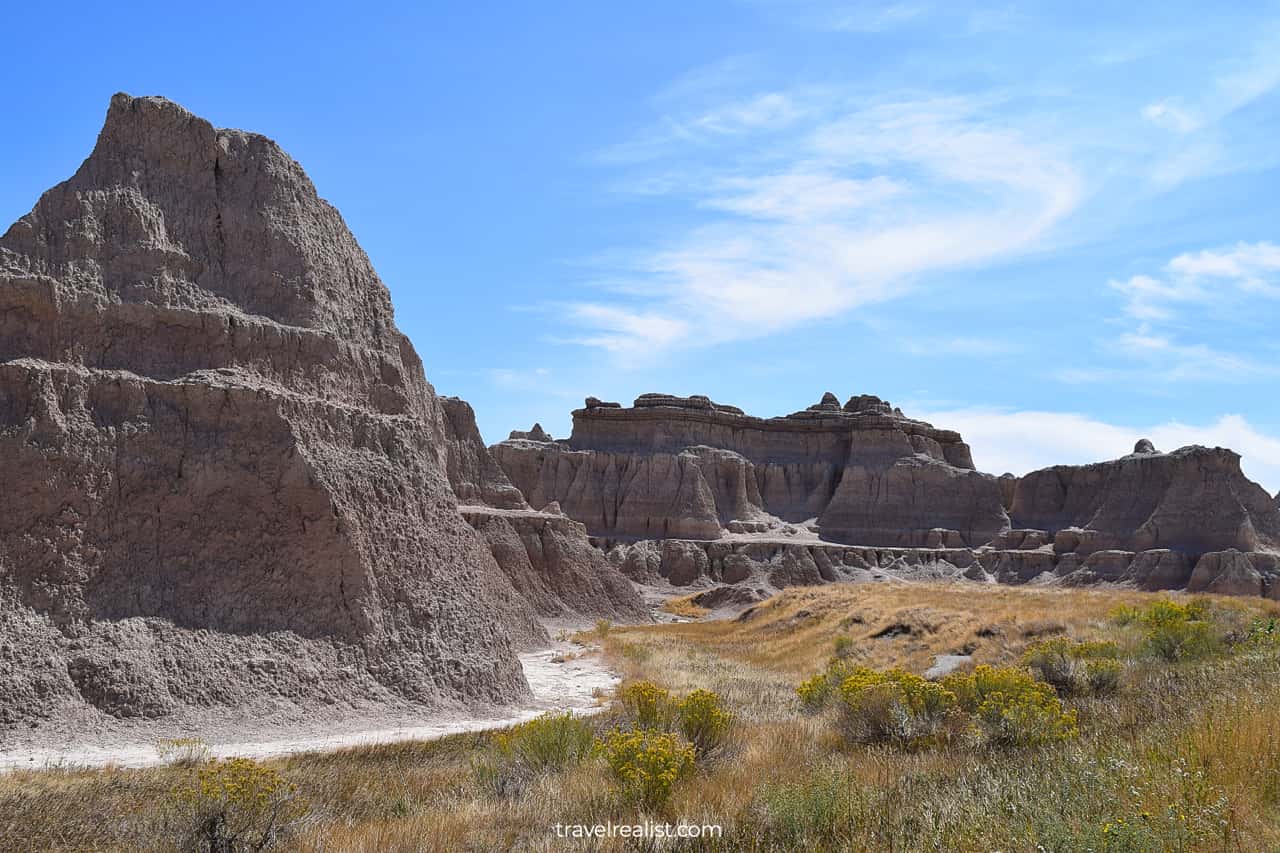
The Castle trail covers 10 miles (16 km). It makes this trail the longest hiking route in Badlands.
But you do not need to hike for long to enjoy the views. You can get close-up views of the badlands formations right from the trailhead. Also, consider taking a short Door trail.
In a way, Badlands is a perfect park for beginner hikers.
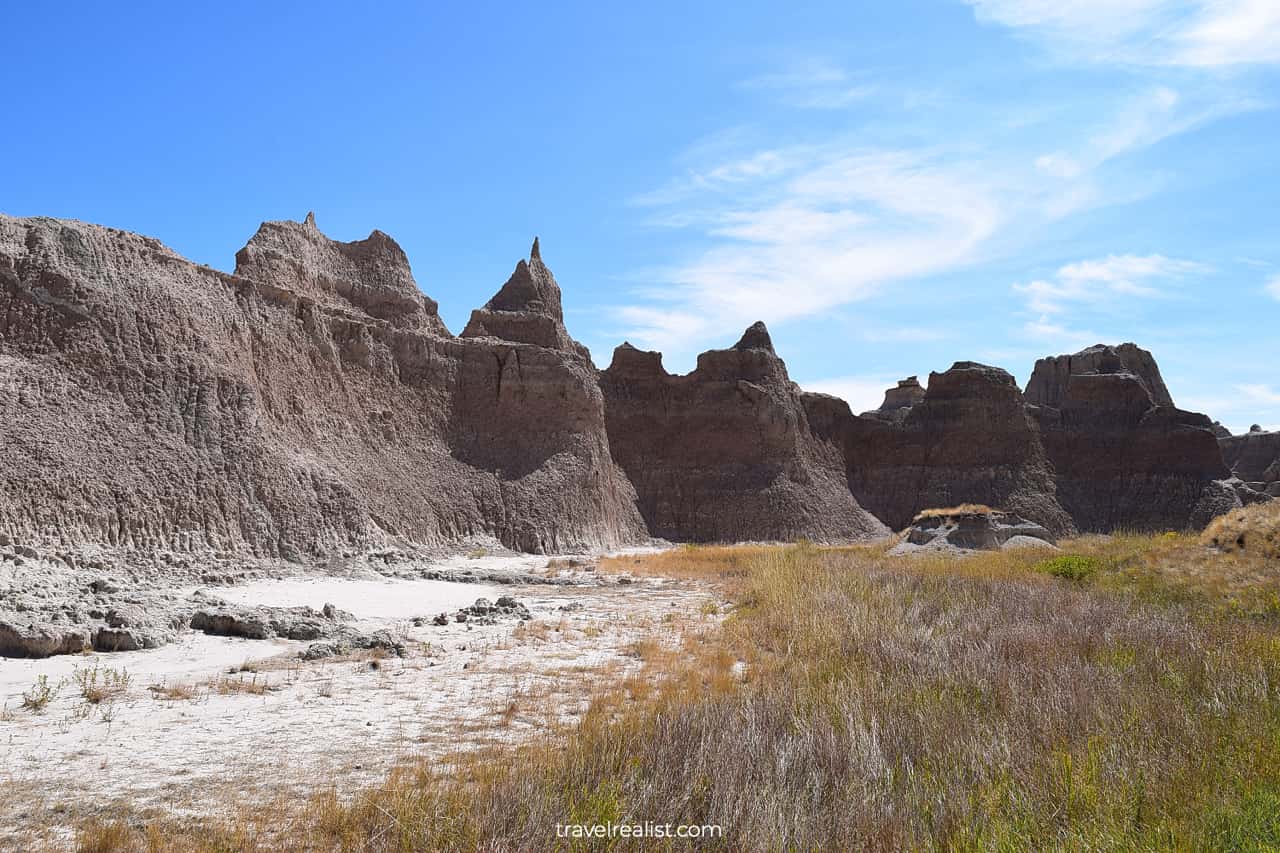
4. Cliff Shelf Nature Trail
The Cliff Shelf Nature Trail gives you another opportunity for a short hike. This loop trail covers 0.5 miles (0.8 km). It has boardwalks and stairs.
But you would need to hike uphill to get the most from this trail. Scenic views serve as a reward for climbing almost 200 ft (61 m).
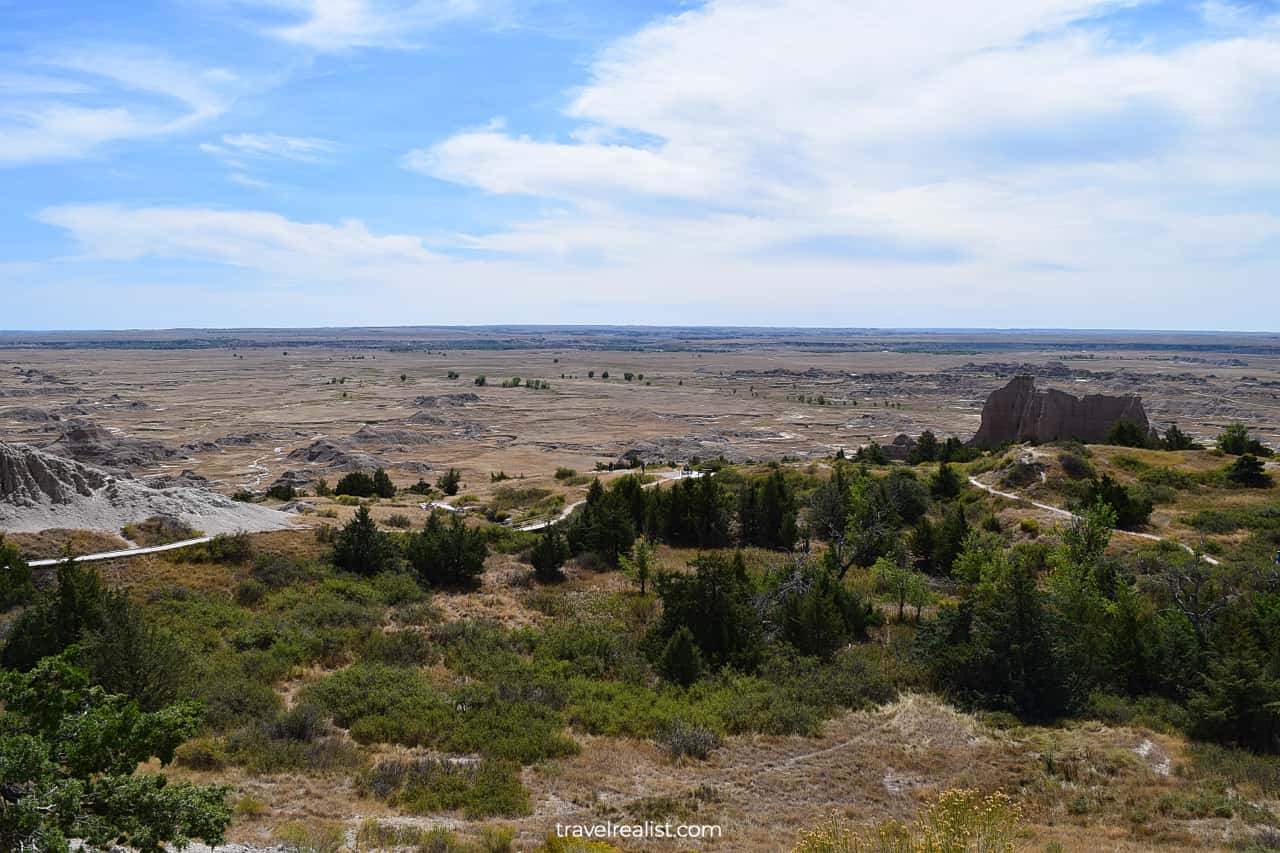
5. White River Valley Overlook
The Cliff Shelf Nature trailhead is right next to the park’s headquarters and Cedar Pass Lodge.
The Badlands Loop Road continues past a few more trailheads to the White River Valley Overlook. This viewpoint attracts wildlife.
Be on the lookout while you drive through this area. You might see bighorn sheep grazing. If you are lucky, they could be closer than 300 ft (91 m) from the Loop Road.
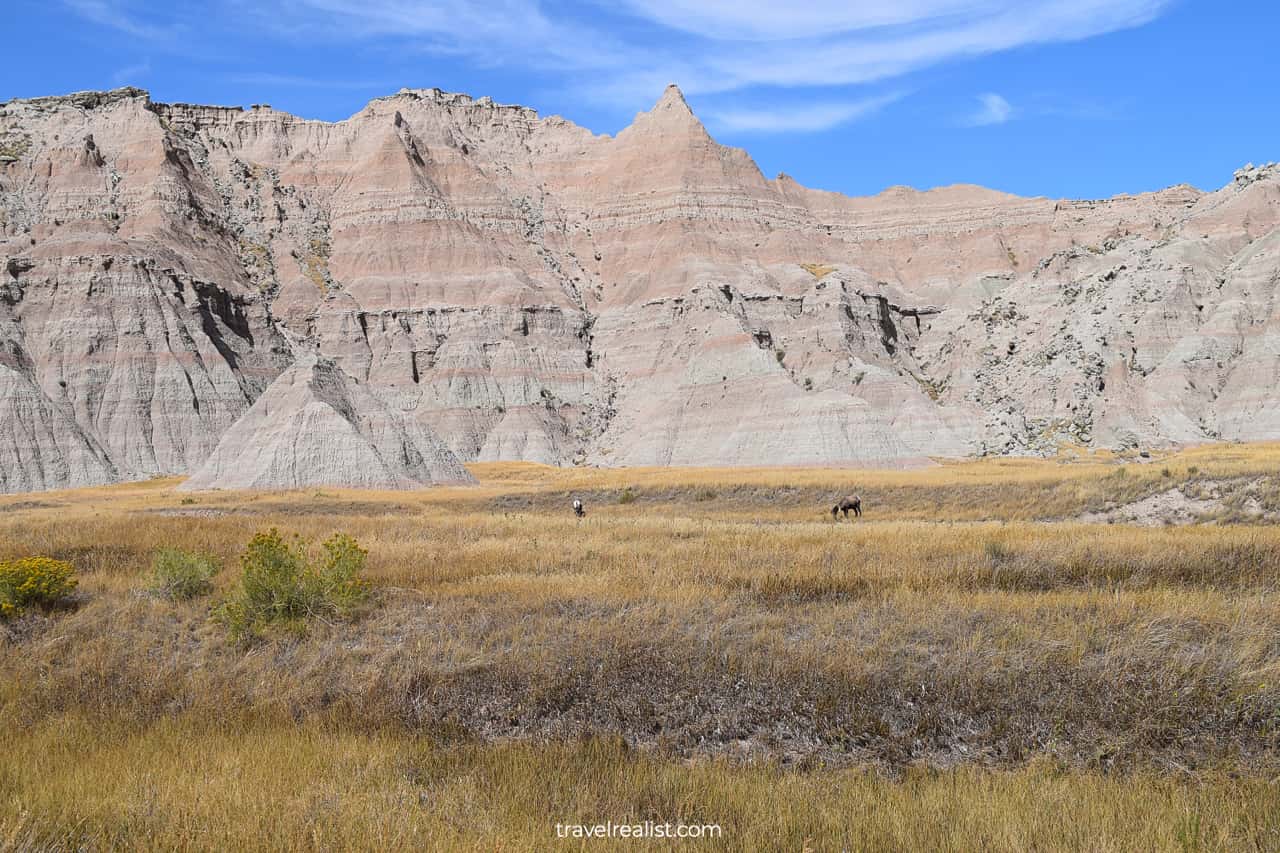
6. Big Foot Pass
The Badlands Loop Road quickly gains elevation as it goes through the Big Foot Pass.
The Big Foot Pass Overlook offers astonishing views. Take a moment to enjoy the badlands formations from the higher ground.
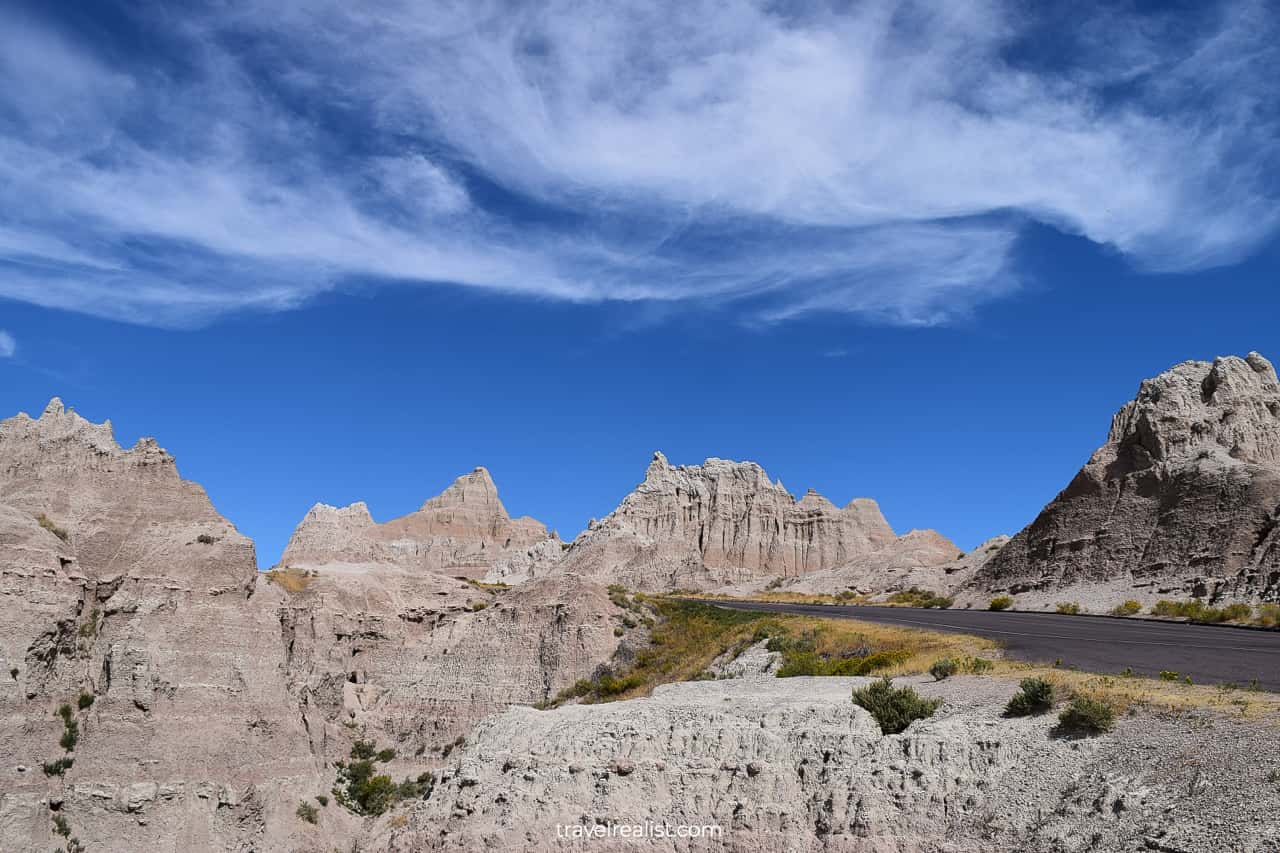
7. Panorama Point
The viewpoints on the Badlands Loop Road become more frequent after the Big Foot Pass. Almost every road turn brings a new stop. The Panorama Point, the next stop, displays colorful badlands formations.
This viewpoint is most similar to the Big Badlands Overlook. You can enjoy views for miles and miles there.
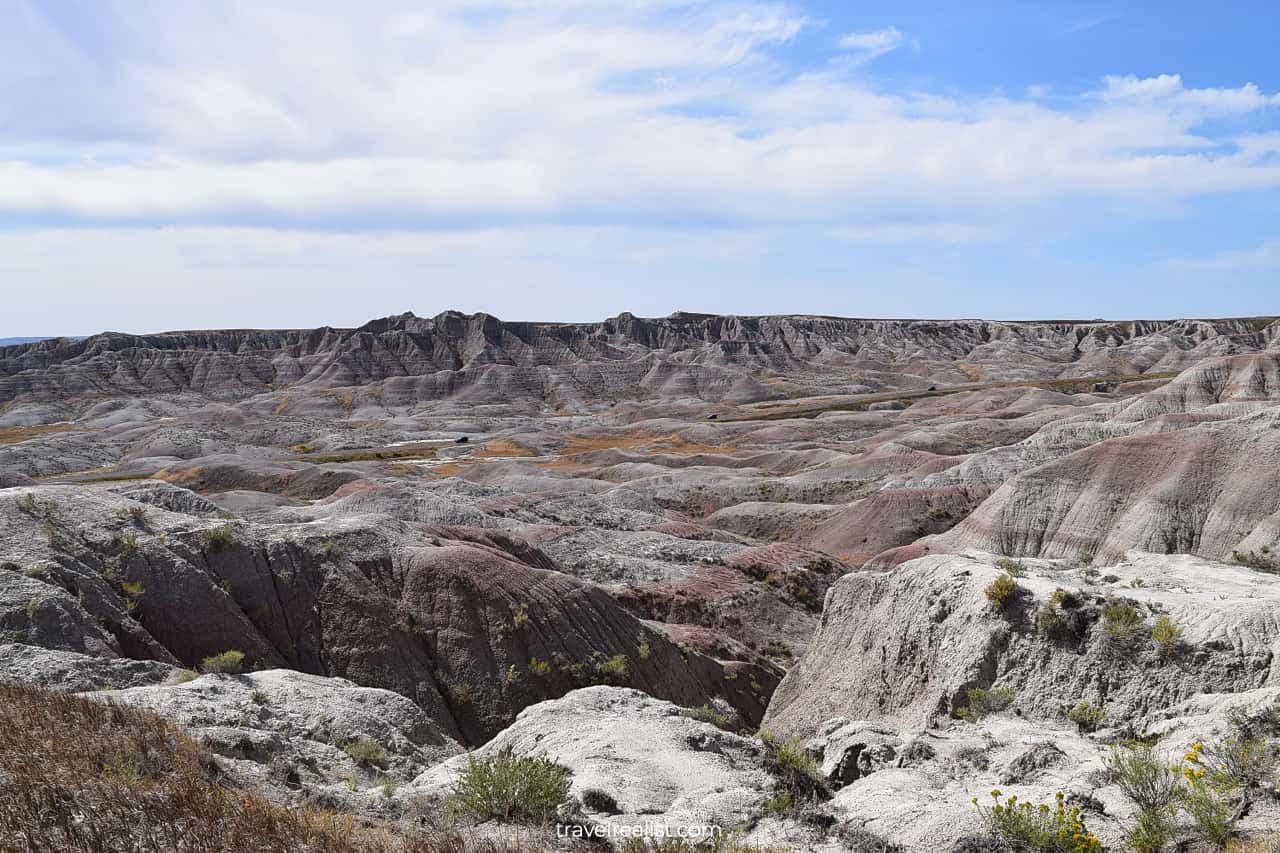
8. Prairie Wind Overlook
The Prairie Wind Overlook is the next viewpoint on the scenic drive. You might feel that it pales in comparison to other viewpoints in Badlands National Park.
You can best describe it as a boardwalk through the endless grass fields. There are barely any formations next to the viewpoint.
But the Prairie Wind Overlook is a known wildlife spot. Grass fields attract bighorn sheep. You might have a close encounter with wildlife at this viewpoint.
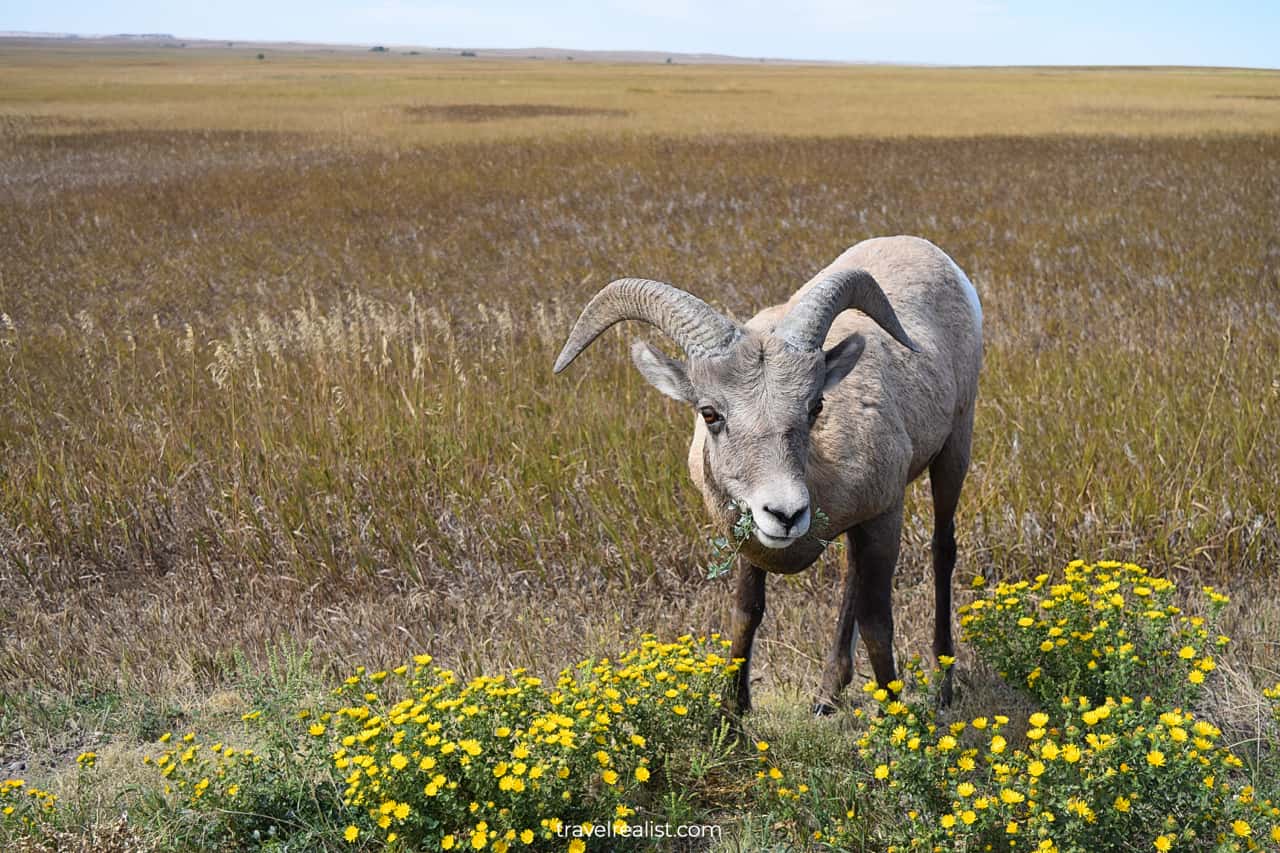
9. Burns Basin Overlook
The Burns Basin Overlook is quite similar to the Panorama Point and the Big Badlands Overlook. Like the earlier viewpoints, it provides panoramic views of the badlands.
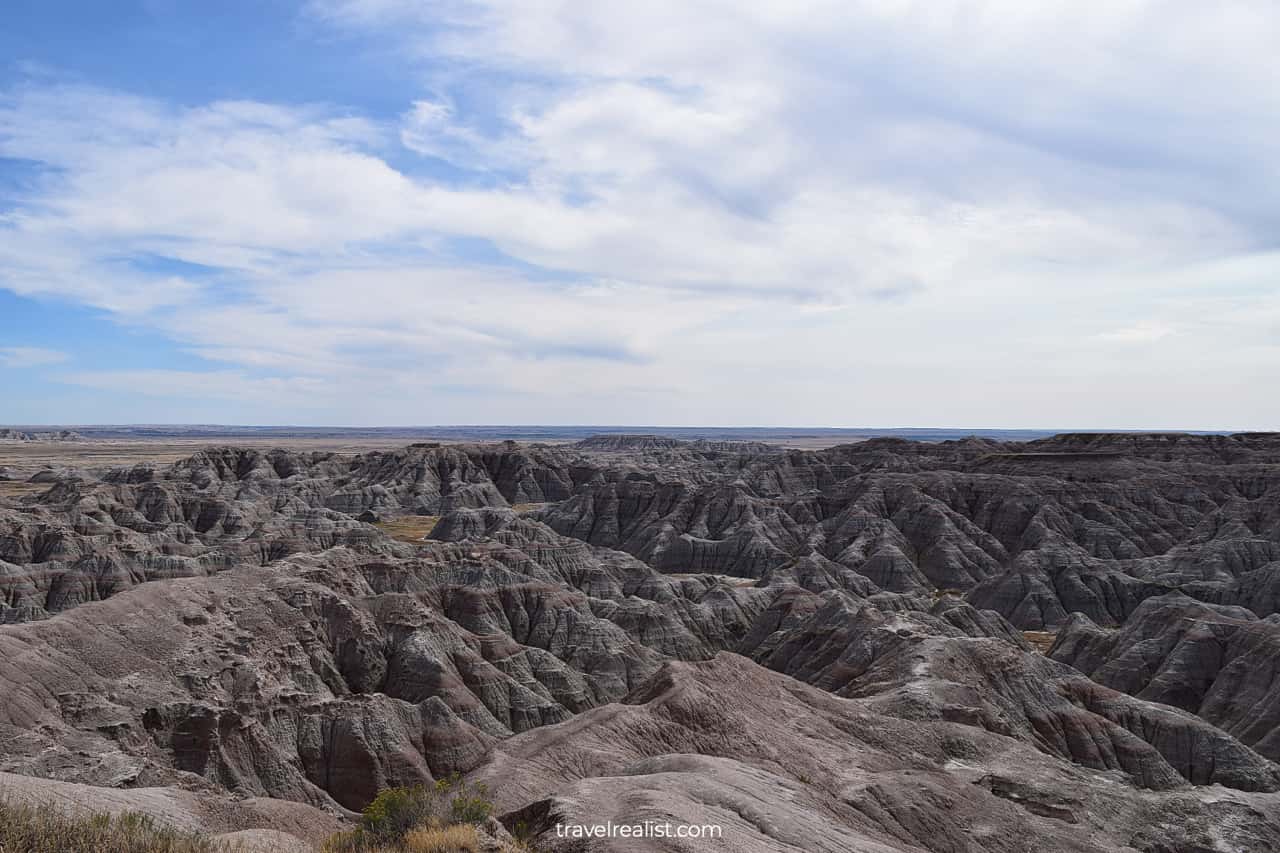
The viewpoints might start to blend in at this point. You should resist the temptation to skip the next few stops. The Badlands Loop Road is about to reveal a few more of its wonders.
10. Homestead Overlook
You are about to enter the 2.5-mi (4-km) area between the Burns Basin and the Homestead Overlooks. It is home to a prairie dog town.
Prairie dogs look little like dogs. They are rodents. These animals are most similar to ground squirrels. You can find them all over the Great Plains.
These animals are quite small. But the prairie dog town in Badlands National Park is right next to the Loop Road. As a result, you can easily spot prairie dogs in Badlands.
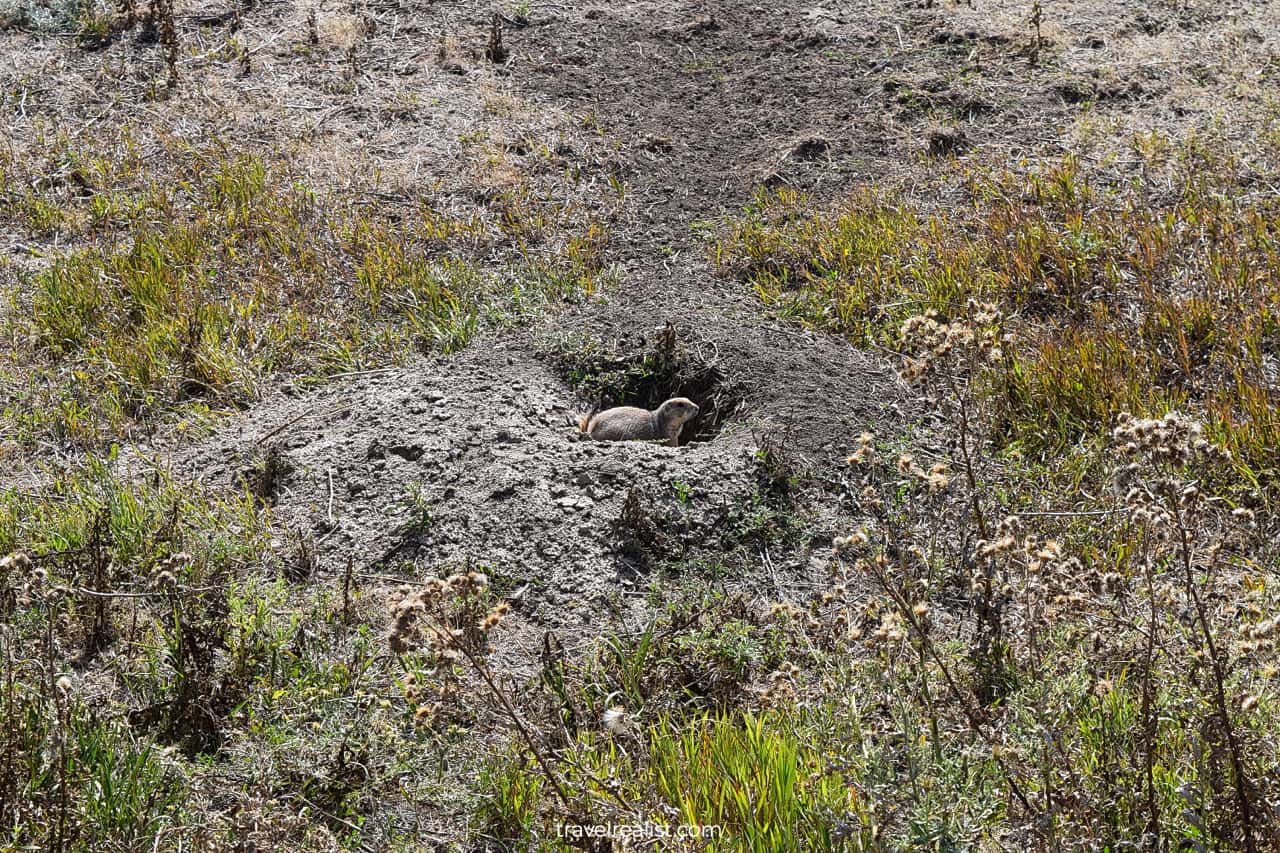
The dogs run and hide whenever they feel danger. They can also cover a fairly long distance by jumping. It is quite a sight to see.
Give yourself a few minutes to observe these creatures. If you stand still and talk quietly, prairie dogs will come out again. Please, do not feed prairie dogs and other wildlife in Badlands.
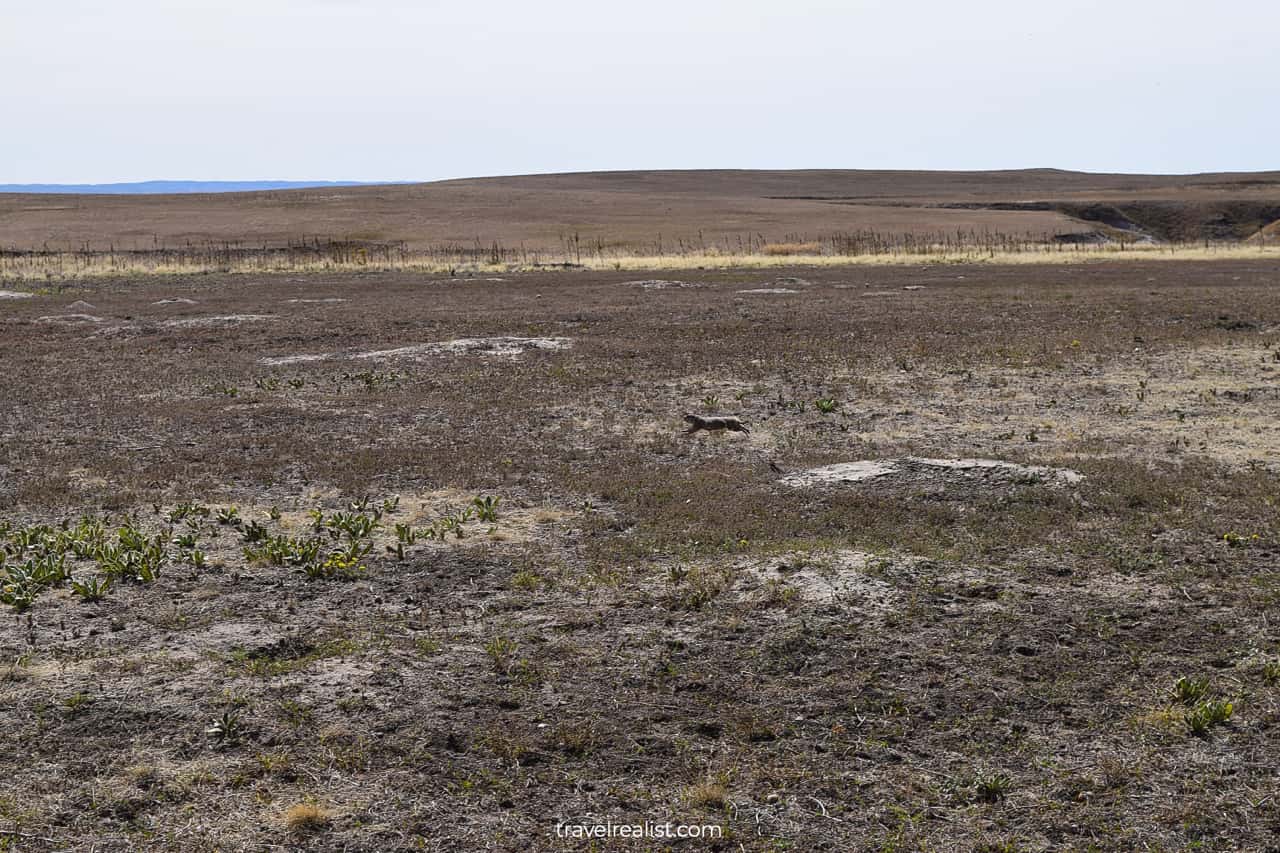
11. Conata Basin Overlook
The Loop Road continues for a few minutes with no viewpoints. But the wait is worth it. The Conata Basin Overlook marks a slight change of scenery. This viewpoint has vivid yellow formations.
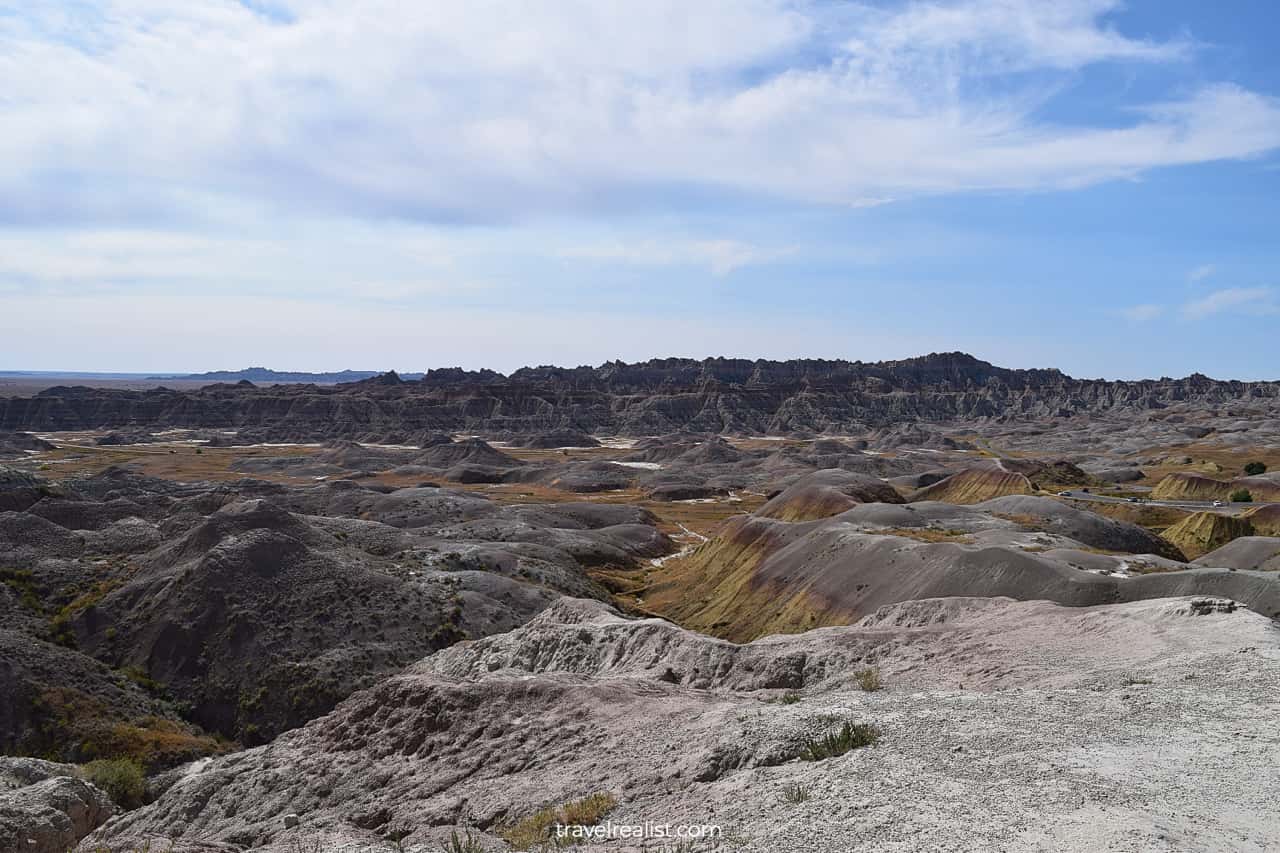
12. Yellow Mounds Overlook
The name of the next viewpoint says its all. The Yellow Mounds are on full display in this area of the park.
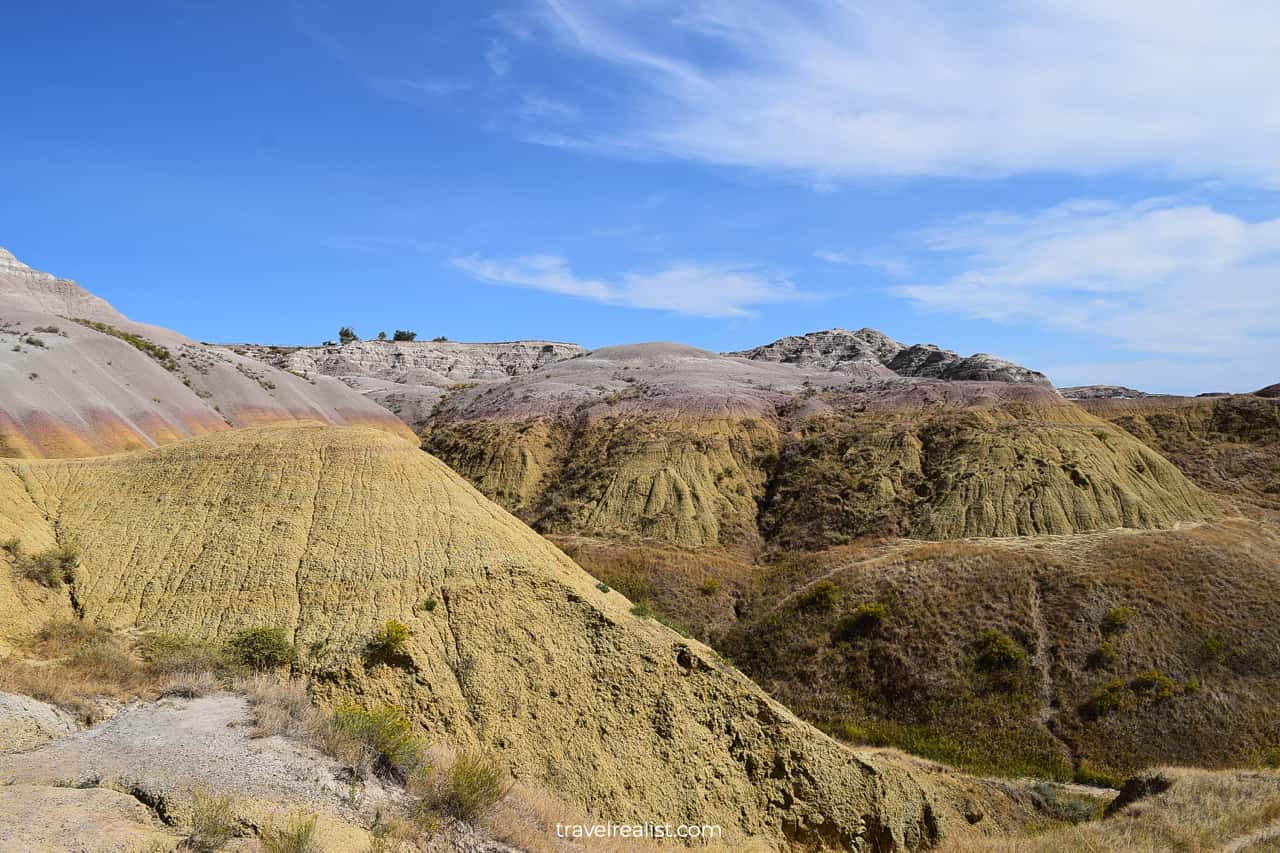
13. Ancient Hunters Overlook
You will enter the Dillon Pass right after the Yellow Mounds Overlook. This picturesque pass is worth a stop at any unnamed pullout.
The Ancient Hunters Overlook is just past the Dillon Pass. This viewpoint provides a close-up view at the badlands rock formations.
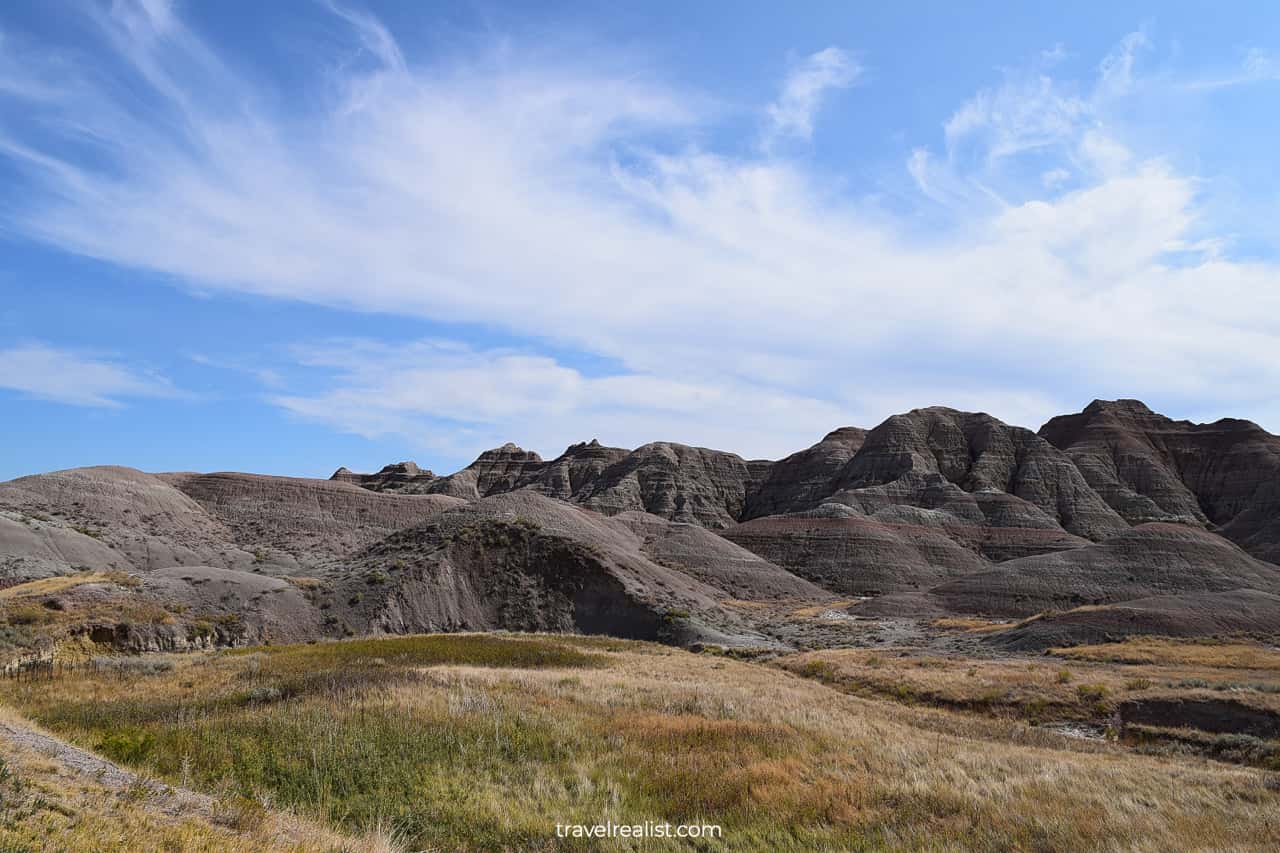
14. Pinnacles Overlook
The Pinnacles Overlook will be your last overlook on the westbound Badlands Loop Road. It is also the closest overlook to the Pinnacles Entrance Station.
Depending on your route, you could explore it during different stages of your Badlands journey.
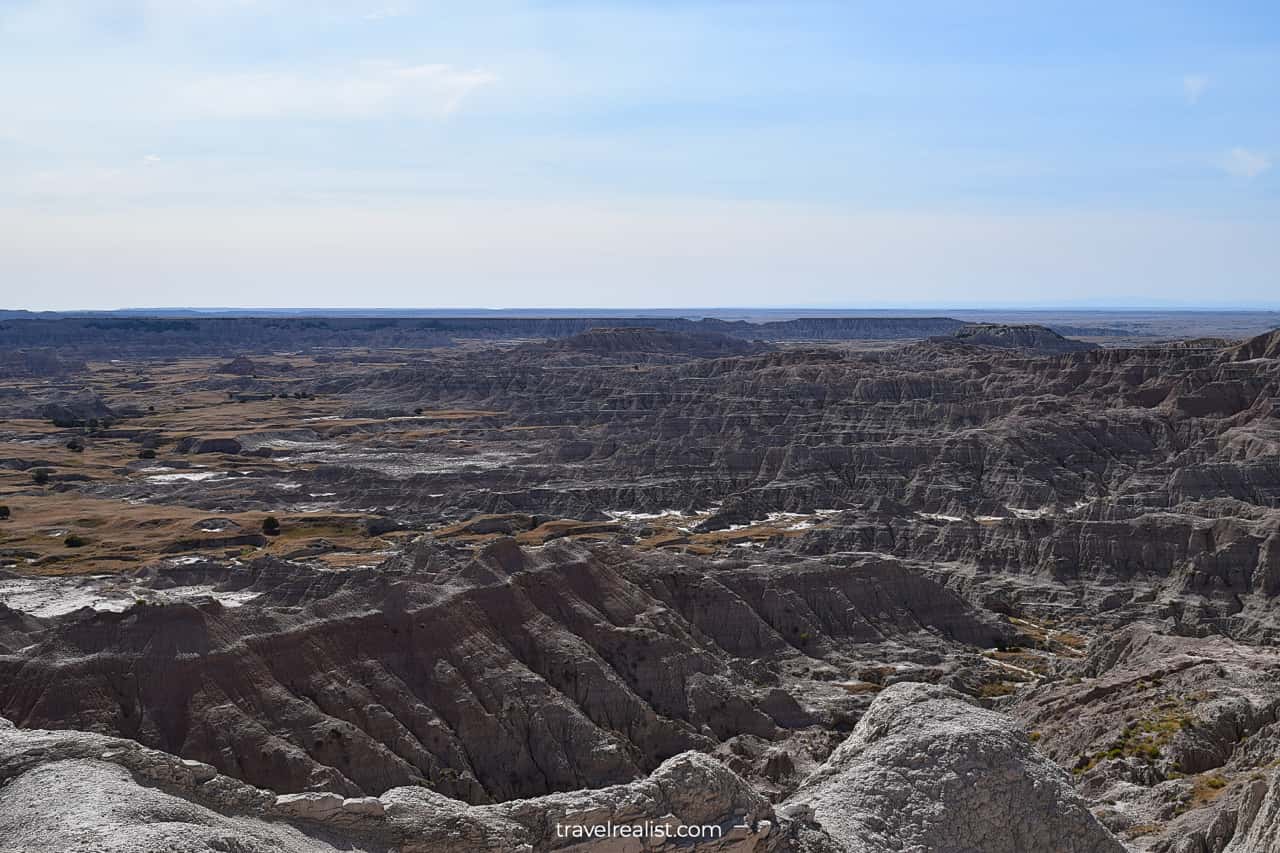
15. Sage Creek Rim Road
This viewpoint shows the differences between badlands and cultivated land. It also marks the start of the Sage Creek Rim Road.
This 25-mi (40-km) dirt road connects Pinnacles Entrance Station with a community of Scenic. All of its viewpoints are in the first half of the road. The rest of the drive goes through the Wilderness Area and Grasslands.
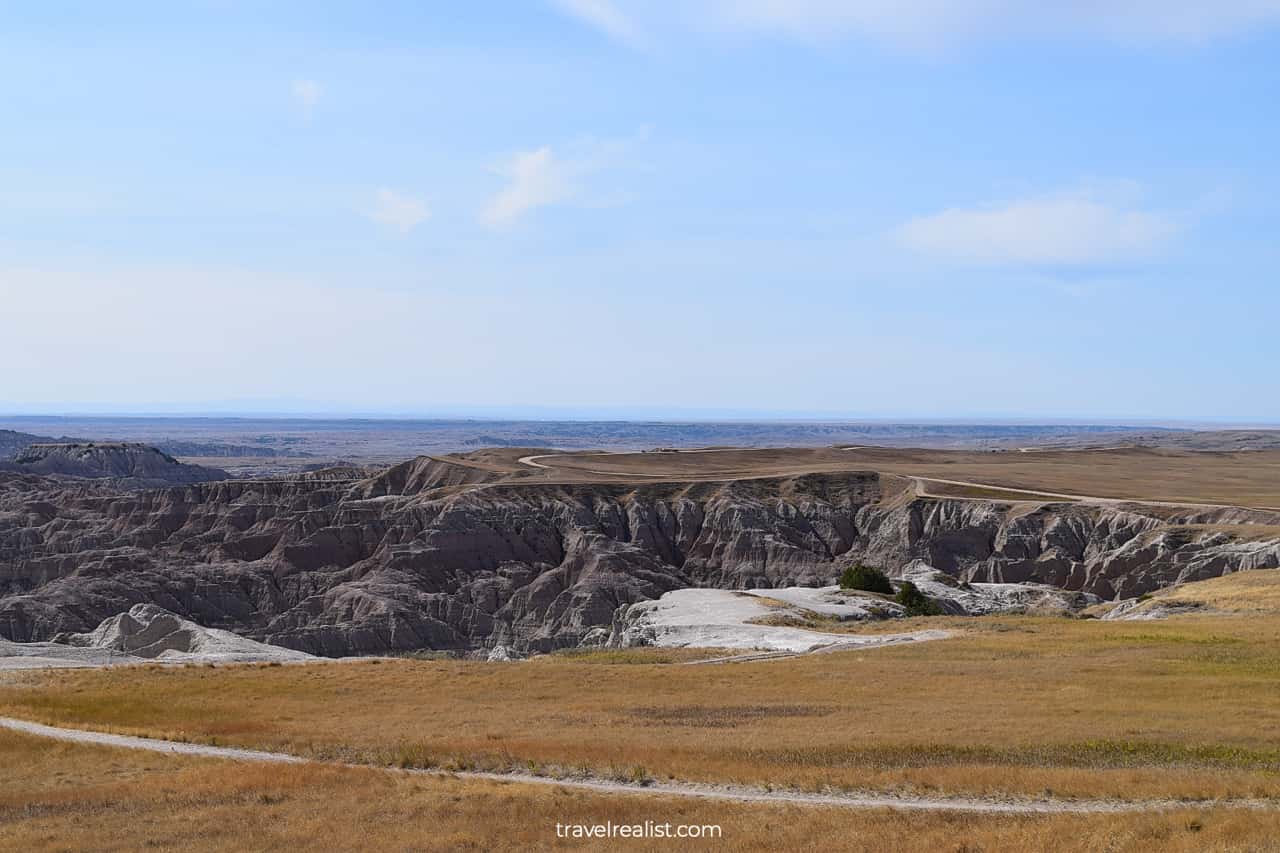
Continue with this Badlands National Park Scenic Loop Drive Guide. You will learn more about ways to get to the sights, entrance requirements, and places to stay.
Getting to Badlands National Park
Badlands National Park is just outside of the Black Hills region of South Dakota. It is only an hour away from Rapid City. Jewel Cave and Wind Cave, two major sights in Black Hills, are within a 2-hour drive.
Badlands is a great road trip destination. Denver, CO is the closest airport hub to Badlands. It takes 6.5 hours to reach the park from the capital of Colorado.
When planning a trip to Badlands National Park, pay attention to the park unit you would like to visit.
- Stronghold Unit is closer to Rapid City. But it has few overlooks and paved roads.
- The Palmer Creek Unit does not have any roads at all.
Even the North Unit has unpaved routes. Look at the Sage Creek Rim Road and the Conata Basin Road. If you do not feel comfortable driving on dirt roads, stick to the viewpoints on the Badlands Loop Road.
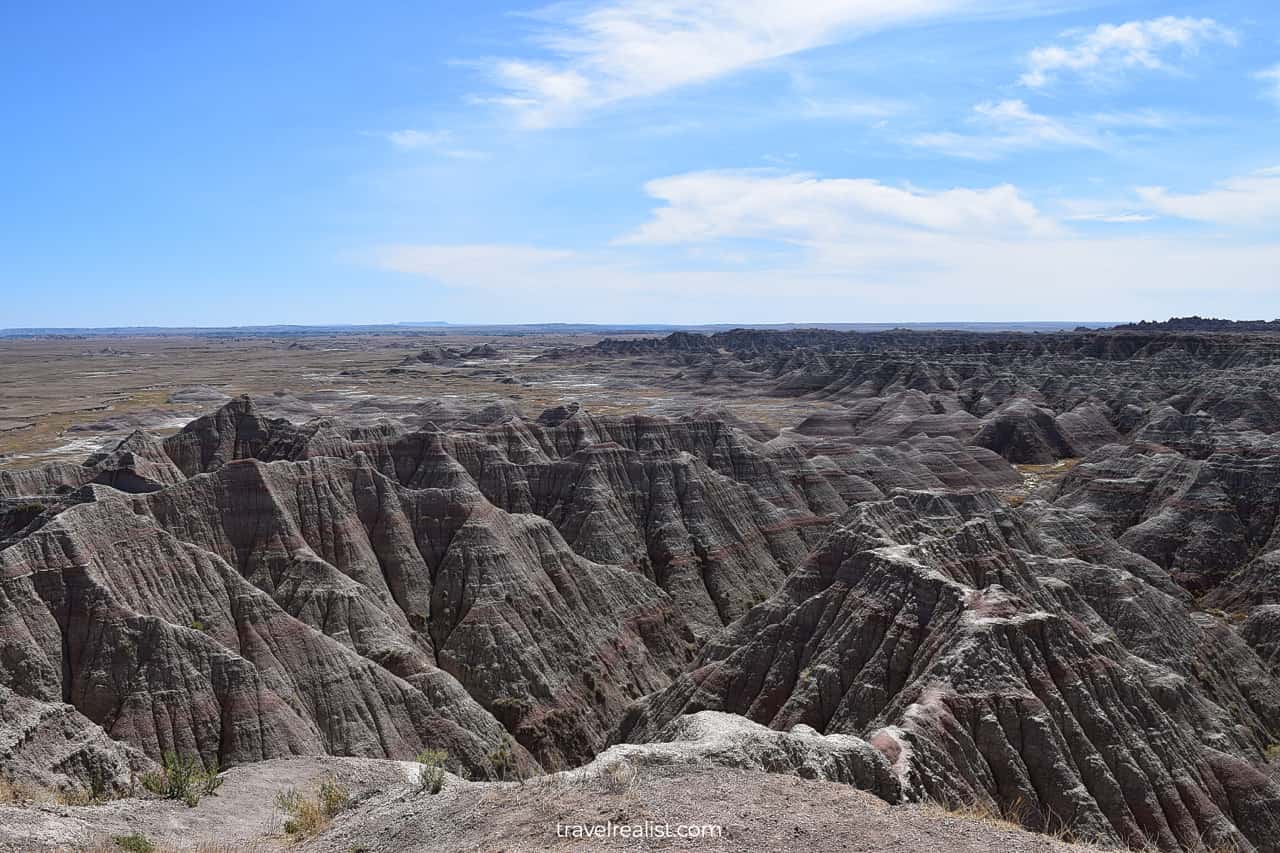
Where to Stay near Badlands
You could choose from a good number of places to stay when planning a Badlands vacation.
The Cedar Pass Lodge is right inside the park boundaries. There are a couple of smaller places to stay right outside of the park in Interior, SD.
For more options continue east or west from the park on Interstate I-90.
- Wall, SD and Rapid City, SD are your best options on the westbound route.
- Kadoka, SD and Murdo, SD are places to look into in the east.
Entrance Requirements & Passes
Badlands National Park charges entrance fees of $30 per car. America the Beautiful annual pass fully covers these fees.
The national park is open 24/7 throughout the year. But the visitor centers close during major public holidays. The dirt roads become impassable in winter and after heavy rainfall.
Consider visiting Badlands National Park from May to September to avoid road closures. This Badlands National Park Guide described a summer visit to Badlands.
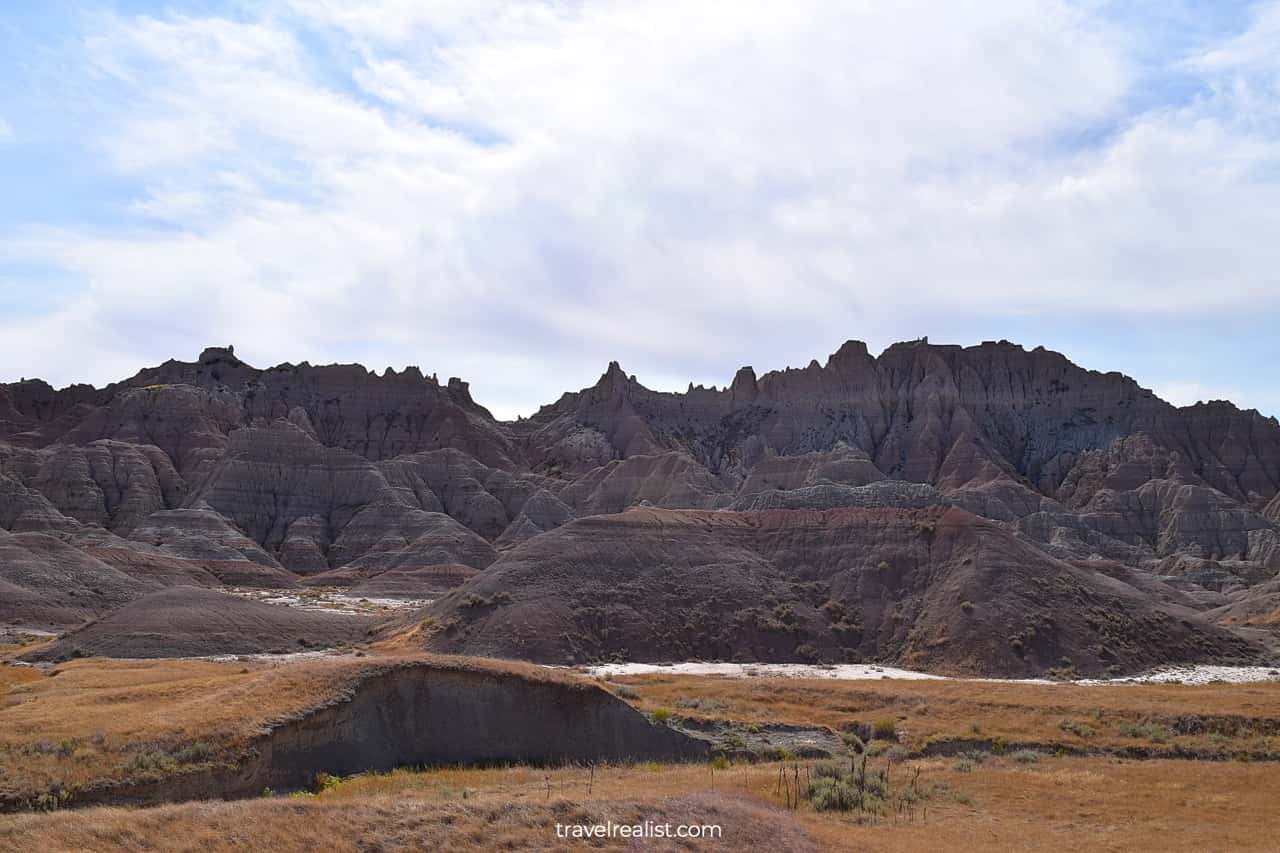
Takeaways: Badlands National Park Scenic Loop Drive
Badlands National Park is a beautiful park. Its formations and canyons are very scenic. But this landscape is not unique to South Dakota.
Similar formations are present from Theodore Roosevelt National Park in North Dakota to Cathedral Gorge State Park in Nevada. You can even see badlands in Petrified Forest in Arizona.
Still, Badlands National Park has an edge over other parks with badlands landscapes. There are a lot more places to stay near Badlands than next to the other sites. And its proximity to the parks and monuments in the Black Hills region speaks in favor of visiting Badlands.
Take a look at this Badlands National Park Scenic Loop Drive Video Guide. And visit the YouTube channel for the latest videos.
Frequently Asked Questions
Badlands refer to the areas of land with the rugged terrain not suitable for agriculture.
Badlands National Park protects a fossil bed and a few wildlife species, from prairie dogs to bighorn sheep.
Badlands National Park is just east of the Black Hills region. It takes about an hour to reach the park from Rapid City. Add another hour to reach major Black Hills sights, like Jewel Cave, Wind Cave, and Mount Rushmore.
Badlands landscape is not unique to this national park. But proximity to Black Hills sights and places to stay make this park worth a visit.
You can drive through Badlands National Park via any of its three major roads:
– Badlands Loop Road: 27-mi paved scenic drive
– Sage Creek Rim Road: 25-mi dirt gravel road
– Conata Basin Road: 8-mi dirt road
Late spring and early fall are the best times to visit Badlands. This way, you can avoid summer crowds and winter road closures.
Half a day is more than enough to drive on the Badlands Loop Road. It is sufficient time to stop at viewpoints, hike short trails, and watch wildlife.
Pinnacles Overlook, Panorama Point, and Big Badlands Overlook are the most scenic viewpoints in Badlands National Park.
The Cedar Pass Lodge is within the park boundaries. Consider Wall, SD and Rapid City, SD for more affordable nearby places to stay.
Badlands charges admission fees of $30 per car.
Safe realist travels!


